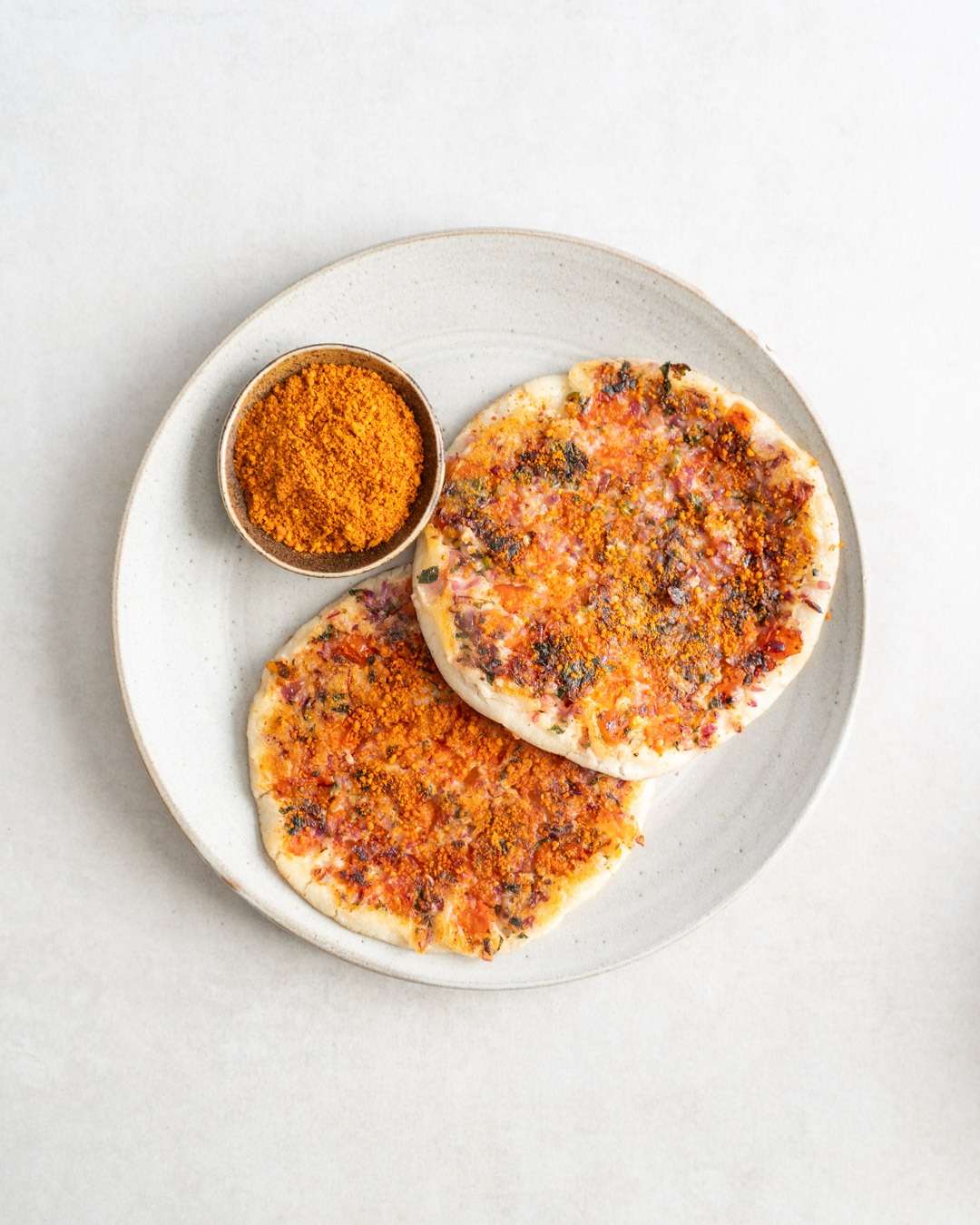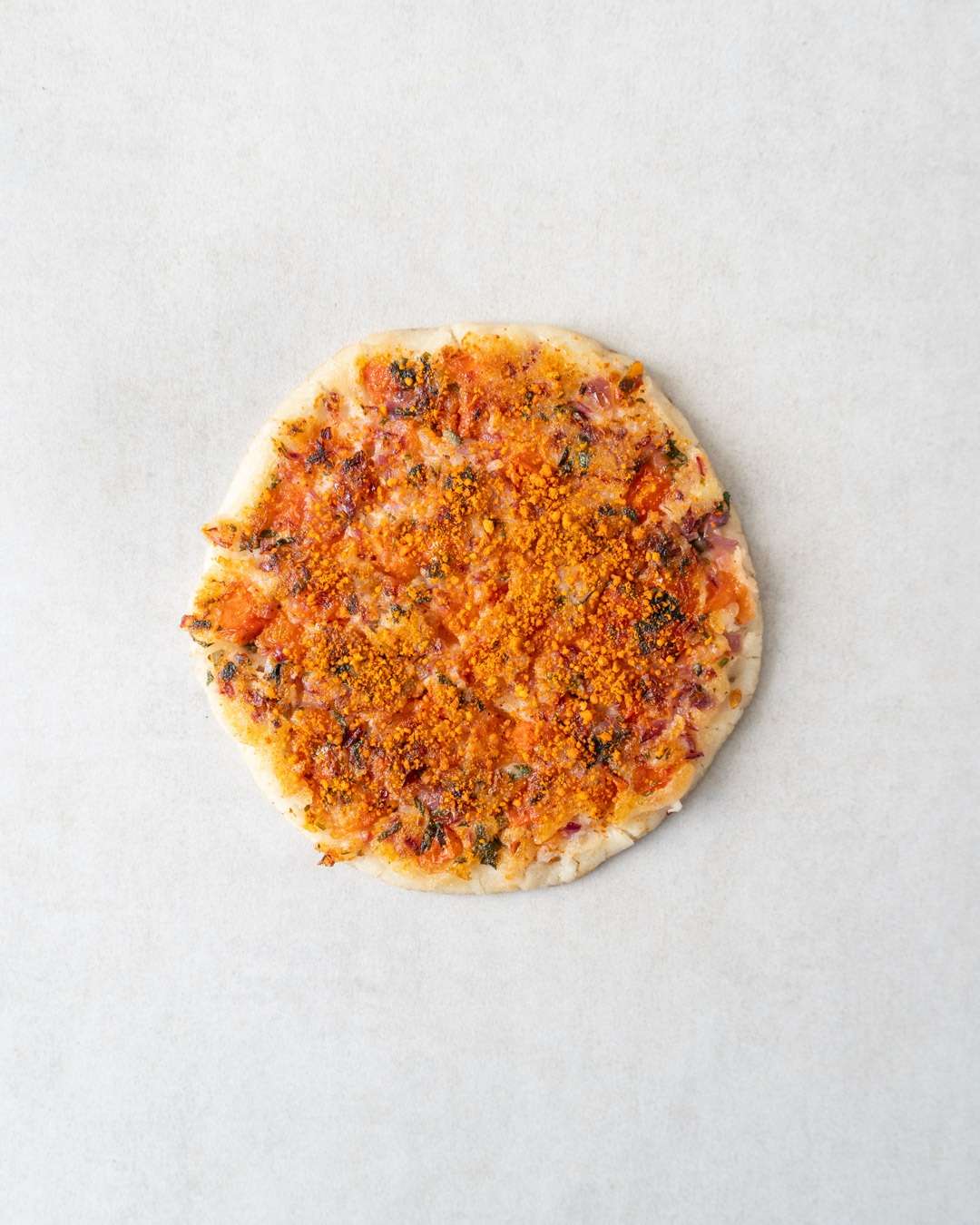Uttapam (Indian Rice & Lentil Pancakes)

What is Uttapam?
Uttapam is a savory South Indian dish that’s often described as a thicker, pancake-like version of dosa. Made with a fermented rice and lentil batter, it has a soft, fluffy texture with a slightly crispy edge. What makes uttapam unique is its topping—usually a mix of onions, tomatoes, green chilies, and herbs—that’s added directly to the batter while it cooks. It’s a wholesome, flavorful dish that’s perfect for breakfast or as a light meal any time of day.
Just like Idli and Dosa, Uttapam is made from a fermented batter of rice and lentils (urad dal). However, rather than steamed in trays or spread out thinly in a pan, it is fried into a thick, fluffy pancake and topped with aromatics like onion, chillis, tomatoes and coriander – a popular breakfast that is traditionally vegan.
Besides a pleasant tangy flavour, the fermentation process converts the carbohydrates and proteins in the batter into easier-to-digest forms and increases the bioavailability of certain nutrients, such as folate, iron and zinc. This is one of the reasons why Uttapam is often named one of India’s healthiest breakfasts.
It’s usually eaten with either a fresh coriander chutney or a fiery Milagai Podi, a powdered condiment that is also known as gunpowder thanks to its explosive flavour.
History of Uttapam
The history of uttapam is closely tied to South Indian culinary traditions, particularly the use of fermented rice and lentil batter. Uttapam likely originated as a way to use up dosa batter that had thickened after fermentation, making it less suitable for spreading into thin, crispy dosas. Instead of discarding the batter, cooks poured it into a thicker pancake form, topping it with vegetables and spices to enhance its flavor. Over time, this simple adaptation became a dish in its own right.
The name “uttapam” is believed to come from Tamil, translating roughly to “poured appam.” This reflects the way the batter is poured and cooked. Historically, uttapam was made in homes across South India and paired with chutneys and sambar, showcasing its role as a practical and wholesome breakfast or snack.

Ingredients You’ll Need to Make Uttapam
For the Batter:
- Idli rice: Provides the base for a soft and fluffy texture.
- Urad dal (husked black gram): Aids fermentation and gives structure to the batter.
- Thin poha (flattened rice): Makes the batter light and soft.
- Fenugreek seeds: Improves fermentation and adds a subtle flavor.
For the Toppings:
- Red onion: Adds a hint of sweetness and depth of flavor.
- Tomato: Brings tanginess and freshness.
- Green chilies: Provides a gentle spicy kick.
- Coriander: Adds freshness and aroma.
- Milagai Podi/Gunpowder (optional): Adds a spicy and savory punch.
- Coriander chutney (optional): Complements the uttapam with a flavorful dip.
How to Make Uttapam (Step-by-Step)
Prepare the Batter. The day before, follow steps 1-4 of this recipe to prepare the batter. Once fermented, it should have a thick pouring consistency, similar to pancake batter. If needed, adjust the consistency with a little water.
Preheat the Pan. Preheat a non-stick frying pan or a well-seasoned skillet. While the pan heats up, peel and dice the onion, chop the tomato, slice the chilies, and chop the coriander leaves. Mix these aromatics with salt in a bowl.
Cook the First Uttapam. Add 1 teaspoon of oil to the hot pan and spread it with a pastry brush. Pour a ladleful of batter (around 1/4th of the batter) into the pan. It should spread naturally into a thick pancake.
Add Toppings and Fry. Turn the heat to medium-low. Once bubbles form on the surface, sprinkle 1/4th of the vegetable mix over the batter. Press the toppings gently with a spatula. Drizzle another teaspoon of oil around the edges and fry until the base is golden and easily releases from the pan (3-4 minutes).
Flip and Cook the Other Side. Flip the uttapam and cook the other side until the vegetables are slightly charred and the batter is cooked through (3-4 minutes). Press gently with a spatula to ensure even cooking.
Serve and Enjoy. Flip the uttapam back and slide it onto a plate. Dust generously with Milagai Podi, if using. Repeat the process with the remaining batter and topping mix. Serve immediately with coriander chutney or more Milagai Podi, if desired.
Uttapam Recipe FAQs
- Can I use store-bought batter? Absolutely! Dosa or idli batter works perfectly for uttapam.
- What other toppings can I use? You can experiment with grated carrots, bell peppers, spinach, or even mushrooms.
- Can I make it gluten-free? Yes! The traditional batter of rice and lentils is naturally gluten-free.
Why You’ll Love This Recipe
- Traditionally vegan
- Simple and adaptable
- Great way to use up leftovers
- Naturally fermented
How to Store Uttapam
If you have leftover uttapams, store them in an airtight container in the fridge for up to 2 days. To reheat, simply warm them on a skillet or in the microwave until heated through. Any extra batter can be refrigerated for 3-4 days or even frozen for later use—just let it thaw at room temperature before cooking.
As an Amazon Associate I receive a small commission from affiliate links on this page.

Uttapam (Savoury Rice & Lentil Pancakes)
Ingredients
Batter
- 300 g idli rice
- 100 g urad dal (husked black gram)
- 30 g thin poha (flattened rice)
- 1 tsp fenugreek seeds
- 1 tsp salt
Toppings
- 1 large red onion
- 1 large tomato
- 2 green chillies
- 30 g coriander
- 1/2 tsp salt
- 4 tbsp vegetable oil for frying
- 2 tbsp Milagai Podi/Gunpowder (optional)
- Coriander chutney (optional)
Instructions
- The day before, follow steps 1-4 of this recipe to make the batter. Once fermented, it should have a thick pouring consistency, similar to a normal pancake batter. Adjust with a little water if needed.
- When the batter is ready, pre-heat a non-stick frying pan or well-seasoned skillet. In the meantime, peel and finely dice the onion and cut the tomato into small pieces. Finely slice the chillies, then trim and discard the lower stems of the coriander and chop the leafier bits. Mix all of the aromatics together in a bowl along with the salt.
- Pour 1 tsp of the oil into the frying pan and spread it out with a pastry brush. Once really hot, use a ladle to pour in one large ladle or around 1/4th of the batter. It should spread by itself into a thick pancake. Turn the heat to medium-low and, once bubbles start to form on the surface, sprinkle over 1/4th of the veg mix, spreading it all over the batter and pressing it in slightly with a spatula. Drizzle another 1 tsp of oil over the pancake and around the edges, then continue frying it until the base easily comes loose and is slightly golden (3-4 minutes).
- Flip the uttapam with a spatula and fry the other side until the veg is slightly charred (3-4 minutes), gently pressing it again with the spatula to make sure the batter cooks evenly. Flip it back and slide it onto a plate, before dusting it with a generous amount of the gunpowder. Then carry on with the rest of the batter.
- Serve immediately, alongside the coriander chutney or more of the gunpowder, if using.

I made the recipe, so yummy 😋 I did not notice the grainy texture of the rice, so why is the rice made grainy, wouldn’t it be easier to soak all in a bowl and mix it till smooth?
I already started a new batch, I’m trying to Kickstart the fermentation with a little bit of the old batter, like sourdough.
The grainy texture helps with the fluffiness of the pancakes. If it’s completely smooth, they’d become a little more dense. I believe it also helps to aerate the batter, making the fermentation a little easier. I’ve heard of some grinding the whole batch in one go though. You can definitely give it a go.